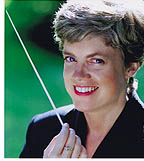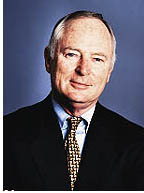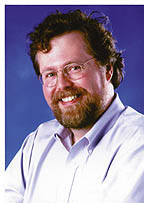Class Notes - April 18, 2000
Class notes features
From the Archives
 According to the archival notes accompanying this photo, these newshounds
are a Daily Princetonian group. Yet most of them look too old to be students,
and at least five of them are the wrong gender for Princeton in the 1950s.
Paw is certain one of its readers can clear this up. Exactly who are these
exuberant truck riders, and why does their sign read, "We'll put out
the fire when the story's on the wire!"?
According to the archival notes accompanying this photo, these newshounds
are a Daily Princetonian group. Yet most of them look too old to be students,
and at least five of them are the wrong gender for Princeton in the 1950s.
Paw is certain one of its readers can clear this up. Exactly who are these
exuberant truck riders, and why does their sign read, "We'll put out
the fire when the story's on the wire!"?
On a musical note
Communication is key for conductor Susan Haig '76
 As artistic director and principal conductor of the Windsor Symphony
Orchestra in Windsor, Ontario, Susan Haig '76 strives to communicate to
her audiences what a particular composer had in mind. "The work of
a conductor is to gain an intimate knowledge of the pieces," she says.
"You're looking for what jumps out in each composition."
As artistic director and principal conductor of the Windsor Symphony
Orchestra in Windsor, Ontario, Susan Haig '76 strives to communicate to
her audiences what a particular composer had in mind. "The work of
a conductor is to gain an intimate knowledge of the pieces," she says.
"You're looking for what jumps out in each composition."
In preparing a piece for performance, Haig sits with the selected score,
usually for hours. "I take it apart layer by layer, examining the pitch,
the relationships in the music, and then how the piece flows through time.
There are many layers," Haig says, "and it's time-consuming, it
takes patience, but it is intriguing."
And it is similar to the work she did as a music student. "The detailed
analysis we did at Princeton was immensely important to me. We learned how
to let each work define itself."
Haig, who grew up in Summit, New Jersey, began piano lessons when she
was four. At seven she knew she had perfect pitch, and when she was in the
fourth grade she started viola lessons. "I knew that I wanted to do
something in music. When I was 13, I became curious about conducting,"
Haig says.
At Princeton, which Haig chose because she could travel easily to New
York City for lessons and performances, she played in the University Orchestra
as a freshman. It wasn't an entirely satisfying experience, "and during
my sophomore year, I played for the Trenton Symphony Orchestra. But what
was really important to me was the Chapel Fellowship under Dean Ernest Gordon.
He was really a spiritual mentor."
Haig emphasizes how stimulating her professors were. "Milton Babbitt
was my adviser. I studied with Paul Lansky, Ed Cone, Claudio Spies, Peter
Westergaard, and Lewis Lockwood. I benefited greatly from my professors'
analytical rigor with their approach to music and from being exposed to
new work."
After earning master's degrees in piano and in conducting at SUNY at
Stony Brook, she began her career with the Juilliard American Opera Centre
as a conducting fellow; she's been scaling the music world ever since, working
for the New York City Opera, Santa Fe Opera, the Canadian Opera Company,
and the Calgary Philharmonic Orchestra, finally settling in Windsor, where
she's been for nine years.
Another facet of her job that is time-consuming and takes patience is
the educational component. She-and her musicians-are counted upon to be
a part of the community, often going into schools and educating future audiences.
"Music directors are expected to be involved in all sorts of functions
now," she says, "but I like the variety of activity."
Over the course of a season-from September through May-Haig puts on 24
major programs. As an educator she tries to "cultivate interest on
the part of a relatively unsophisticated audience. We present 20th-century
works: Bartok, Stravinsky-and we do lots of premieres of Canadian work.
We present the programs in a less formal fashion. For instance, we give
a short description before we perform any piece. Three sentences maximum-and
it prepares people for listening."
As a conductor she's "operating on several levels at once. First,
you're assessing what you're hearing and deciding if the balance is good
and if anything needs changing. You're also looking ahead to see what's
coming.
"In rehearsal, you're making judgments: Should I stop? You have
to decide, because you're trying to make the most efficient music possible.
You can't stop every time or the rehearsal time will end before you're finished.
I find performance quite liberating, and rehearsal more demanding.
"When you're performing, it's the most wonderful part because you're
making music in front of an audience. The bottom line in music is joy."-L.O.
California Endowment
 California communities looking for money to start a health program or
to bolster an existing health organization can turn to the California Endowment,
whose president and CEO is E. Lewis Reid '58.
California communities looking for money to start a health program or
to bolster an existing health organization can turn to the California Endowment,
whose president and CEO is E. Lewis Reid '58.
Created in 1996 after Blue Cross of California went from non-profit status
to a for-profit organization, the California Endowment has $3.5 billion
in assets and is charged with distributing money to groups that address
health issues in the state.
The endowment works with a variety of groups, including independent charities,
local public health agencies, churches, and Native American tribes. To date,
it has granted more than $300 million to 570 community-based organizations.
In his job as president and CEO of a wealthy foundation, Reid hopes to
pioneer new solutions for the health problems of the California people.
Last year, at a roundtable discussion that included President Clinton, Reid
noted that "foundations have an advantage over business and government-a
long horizon. Corporate America has a horizon only one earnings quarter
away, and government often works in annual budget cycles. Foundations can
take a longer view. We don't have to create profits quarter by quarter.
We can work on programs that may take many years to produce the health changes
communities are seeking."
Reid knows that foundations can take risks and that they have the flexibility
to test different models for solving the same problem-programs do not have
to be applied on a state-wide or nation-wide basis.
-Michael Arges '75
The California Endowment, 21650 Oxnard Street, Suite 1200, Woodland Hills,
CA 91367; 818-703-3311, fax: 818-703-4193, www.calendow.org.
In on the ground floor of Microsoft
Nathan Myhrvold *83 knows the computer revolution has just begun
 Stephen Hawking is still waiting.
Stephen Hawking is still waiting.
One year into a postdoctoral fellowship with the famed British physicist,
Nathan Myhrvold *83 interrupted his studies to work on a computer program
with some old graduate school friends. The rest is a significant part of
20th-century history-the development of a point-and-click graphical operating
system that helped bring personal computers to the masses and make Microsoft
one of the most brilliant American success stories ever. Myhrvold, still
at Microsoft as Bill Gates's chief technology officer 14 years later, laughs
when asked if he plans to finish the postdoc. "When I announced my
leave of absence from Microsoft, Hawking e-mailed me and said, 'I suppose
you'll be returning now.'"
Not exactly. Myhrvold, in the midst of a year's leave from Microsoft,
is instead pursuing some of his other eclectic passions-dinosaurs, notably.
In addition to pleasure-traveling around the world with his twin sons, he
has been prospecting in eastern Montana for brontosaurus and other dinosaur
bones. While his academic training is in physics, not paleontology, don't
get the idea that Myhrvold is merely playing around. His moonlighting has
produced research-a computer-aided exploration of the tail dynamics of the
diplodocids-worthy of publication in a scholarly journal.
That he could take such a leave pleases Myhrvold tremendously. When you're
someone who has been in with Microsoft since the ground floor, time is about
the only commodity you find in short supply. The Seattle Times reported
last year that his Microsoft holdings were worth $275 million.
"I realized no one was going to walk in and say, 'Nathan, you've
done such a great job. Why don't you take a lot of time off?'" Myhrvold
said in a recent interview. "The more responsibility and success you
get, the less time you have. Time to do what you want is the ultimate luxury.
I've had a fantastic job at Microsoft-I love the work I've done-but I couldn't
see continuing to make that the only thing I do. I thought it was time to
try something else for a while."
Given his life before Microsoft, it's surprising that he has been with
Gates and company as long as he has. An academic prodigy who skipped four
grades growing up in Southern California, Myhrvold earned his undergraduate
and master's degrees at UCLA before coming to Princeton to pursue a doctorate
in applied mathematics. He intended to become a researcher-scholar, and
as evidenced by Hawking's interest in him, Myhrvold had very bright prospects
in academia.
But something lured him away from Cambridge University in 1984, after
the first year of the three-year postdoc with Hawking. A venture capitalist
was interested in a software project Myhrvold had worked on as a graduate
student. Lured in part by the need for money for his family -Myhrvold is
married to Rosemarie Havranek *81, a Romance languages scholar he met at
Princeton-he went to work with his brother and three others in an attic
in Berkeley, California. Their product, a precursor of the now-ubiquitous
Windows operating system, looked like a winner to Gates, who purchased the
start-up and relocated Myhrvold and the others to Seattle.
"I'm very lucky to have lived in the golden age of nerds, in a period
when technology is transforming society, and lucky to have played some part
in it," Myhrvold says. "I'm also very excited about what's going
forward."
It is that next chapter in the computer-driven technology revolution
that fires Myhrvold's imagination these days. The chief architect of Microsoft's
vast research operation, he has a philosophical zeal about the value of
fundamental scientific research, both for his company and the nation. Microsoft
has 450 full-time researchers employed at centers in Redmond, Washington;
San Francisco; England; and China, working on everything from the next generation
of computer games to artificial intelligence to the mathematical underpinnings
of computer science. Myhrvold is also a member of the board of the Institute
for Advanced Studies in Princeton, which he calls the ultimate ivory tower.
"We have a funny way of thinking about research in this country,"
Myhrvold says. "We live in a society that has been shaped by technology
to an enormous degree. It all came from somebody's research. It didn't wash
up on a beach or fall from space. Despite that, many people in the technology
industry don't invest in research directly. That's for 'other people.' .
. . If you take a single research project and ask whether it will pay off,
the answer is that we don't know. But with a large set of people and research
projects, there are almost always enormous returns."
The personal computer. Windows. The Internet. What's the next big thing?
The answer is unknown, but Myhrvold is sure that the most exciting developments
are yet to come. "The computer revolution has just begun," he
says. "What we've seen so far is nothing."
-Tom Krattenmaker
Tom Krattenmaker is a freelance writer in Pennsylvania.
GO TO
the Table of Contents of the current issue
GO TO
PAW's home page
paw@princeton.edu
 According to the archival notes accompanying this photo, these newshounds
are a Daily Princetonian group. Yet most of them look too old to be students,
and at least five of them are the wrong gender for Princeton in the 1950s.
Paw is certain one of its readers can clear this up. Exactly who are these
exuberant truck riders, and why does their sign read, "We'll put out
the fire when the story's on the wire!"?
According to the archival notes accompanying this photo, these newshounds
are a Daily Princetonian group. Yet most of them look too old to be students,
and at least five of them are the wrong gender for Princeton in the 1950s.
Paw is certain one of its readers can clear this up. Exactly who are these
exuberant truck riders, and why does their sign read, "We'll put out
the fire when the story's on the wire!"? As artistic director and principal conductor of the Windsor Symphony
Orchestra in Windsor, Ontario, Susan Haig '76 strives to communicate to
her audiences what a particular composer had in mind. "The work of
a conductor is to gain an intimate knowledge of the pieces," she says.
"You're looking for what jumps out in each composition."
As artistic director and principal conductor of the Windsor Symphony
Orchestra in Windsor, Ontario, Susan Haig '76 strives to communicate to
her audiences what a particular composer had in mind. "The work of
a conductor is to gain an intimate knowledge of the pieces," she says.
"You're looking for what jumps out in each composition." California communities looking for money to start a health program or
to bolster an existing health organization can turn to the California Endowment,
whose president and CEO is E. Lewis Reid '58.
California communities looking for money to start a health program or
to bolster an existing health organization can turn to the California Endowment,
whose president and CEO is E. Lewis Reid '58. Stephen Hawking is still waiting.
Stephen Hawking is still waiting.